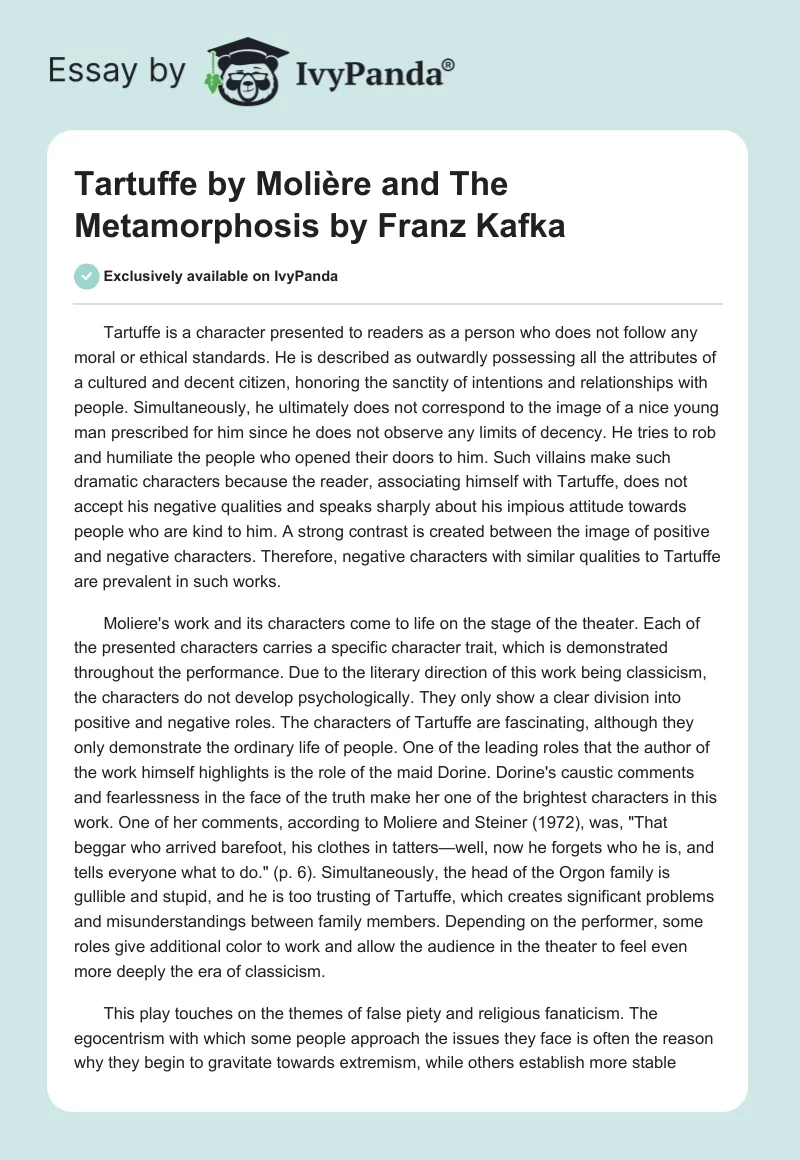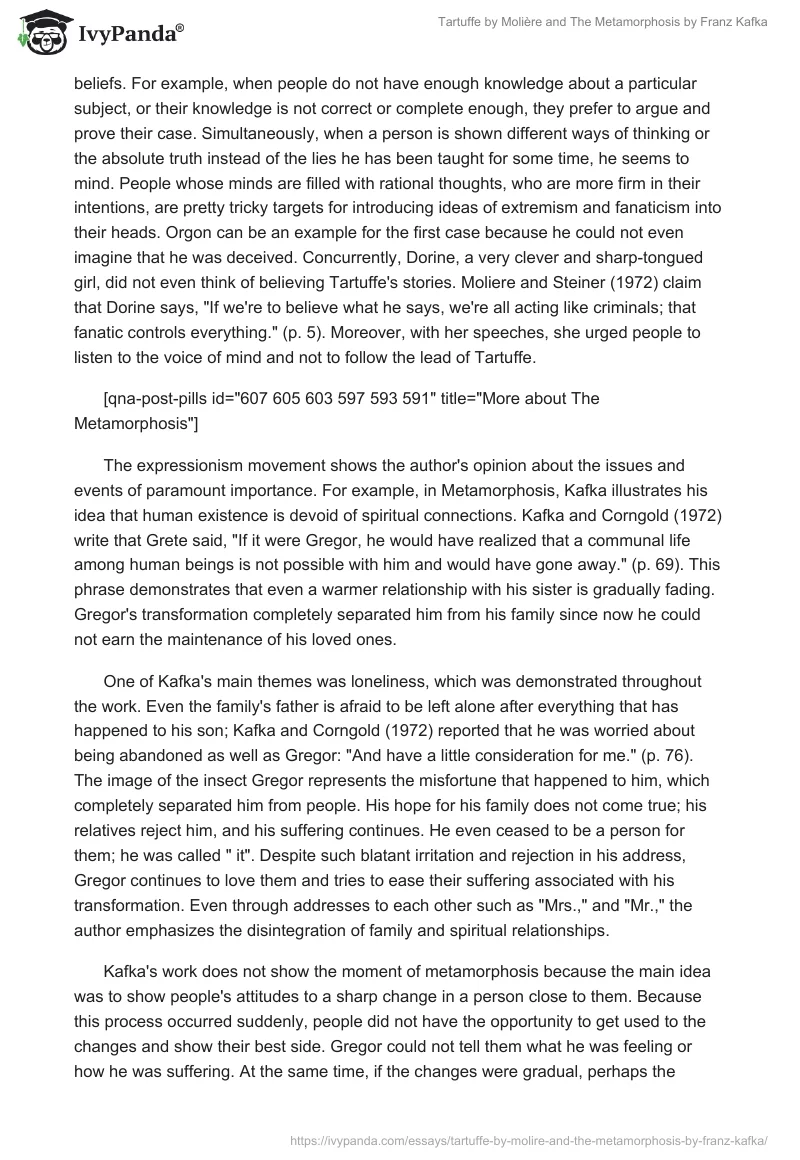Tartuffe is a character presented to readers as a person who does not follow any moral or ethical standards. He is described as outwardly possessing all the attributes of a cultured and decent citizen, honoring the sanctity of intentions and relationships with people. Simultaneously, he ultimately does not correspond to the image of a nice young man prescribed for him since he does not observe any limits of decency. He tries to rob and humiliate the people who opened their doors to him. Such villains make such dramatic characters because the reader, associating himself with Tartuffe, does not accept his negative qualities and speaks sharply about his impious attitude towards people who are kind to him. A strong contrast is created between the image of positive and negative characters. Therefore, negative characters with similar qualities to Tartuffe are prevalent in such works.
Moliere’s work and its characters come to life on the stage of the theater. Each of the presented characters carries a specific character trait, which is demonstrated throughout the performance. Due to the literary direction of this work being classicism, the characters do not develop psychologically. They only show a clear division into positive and negative roles. The characters of Tartuffe are fascinating, although they only demonstrate the ordinary life of people. One of the leading roles that the author of the work himself highlights is the role of the maid Dorine. Dorine’s caustic comments and fearlessness in the face of the truth make her one of the brightest characters in this work. One of her comments, according to Moliere and Steiner (1972), was, “That beggar who arrived barefoot, his clothes in tatters—well, now he forgets who he is, and tells everyone what to do.” (p. 6). Simultaneously, the head of the Orgon family is gullible and stupid, and he is too trusting of Tartuffe, which creates significant problems and misunderstandings between family members. Depending on the performer, some roles give additional color to work and allow the audience in the theater to feel even more deeply the era of classicism.
This play touches on the themes of false piety and religious fanaticism. The egocentrism with which some people approach the issues they face is often the reason why they begin to gravitate towards extremism, while others establish more stable beliefs. For example, when people do not have enough knowledge about a particular subject, or their knowledge is not correct or complete enough, they prefer to argue and prove their case. Simultaneously, when a person is shown different ways of thinking or the absolute truth instead of the lies he has been taught for some time, he seems to mind. People whose minds are filled with rational thoughts, who are more firm in their intentions, are pretty tricky targets for introducing ideas of extremism and fanaticism into their heads. Orgon can be an example for the first case because he could not even imagine that he was deceived. Concurrently, Dorine, a very clever and sharp-tongued girl, did not even think of believing Tartuffe’s stories. Moliere and Steiner (1972) claim that Dorine says, “If we’re to believe what he says, we’re all acting like criminals; that fanatic controls everything.” (p. 5). Moreover, with her speeches, she urged people to listen to the voice of mind and not to follow the lead of Tartuffe.
The expressionism movement shows the author’s opinion about the issues and events of paramount importance. For example, in Metamorphosis, Kafka illustrates his idea that human existence is devoid of spiritual connections. Kafka and Corngold (1972) write that Grete said, “If it were Gregor, he would have realized that a communal life among human beings is not possible with him and would have gone away.” (p. 69). This phrase demonstrates that even a warmer relationship with his sister is gradually fading. Gregor’s transformation completely separated him from his family since now he could not earn the maintenance of his loved ones.
One of Kafka’s main themes was loneliness, which was demonstrated throughout the work. Even the family’s father is afraid to be left alone after everything that has happened to his son; Kafka and Corngold (1972) reported that he was worried about being abandoned as well as Gregor: “And have a little consideration for me.” (p. 76). The image of the insect Gregor represents the misfortune that happened to him, which completely separated him from people. His hope for his family does not come true; his relatives reject him, and his suffering continues. He even ceased to be a person for them; he was called ” it”. Despite such blatant irritation and rejection in his address, Gregor continues to love them and tries to ease their suffering associated with his transformation. Even through addresses to each other such as “Mrs.,” and “Mr.,” the author emphasizes the disintegration of family and spiritual relationships.
Kafka’s work does not show the moment of metamorphosis because the main idea was to show people’s attitudes to a sharp change in a person close to them. Because this process occurred suddenly, people did not have the opportunity to get used to the changes and show their best side. Gregor could not tell them what he was feeling or how he was suffering. At the same time, if the changes were gradual, perhaps the people around him would be able to get used to them and take more care of his misfortune. The loved ones would get used to a particular pattern of behavior and continue to support it.
References
Molière, & Steiner, P. L. (2009). Tartuffe and the misanthrope. Hackett Pub.
Franz Kafka, & Corngold, S. (1972). The metamorphosis by Franz Kafka. Bantam Books, Cop.


